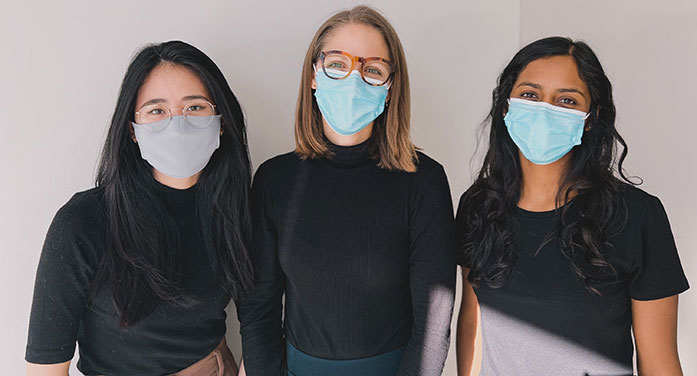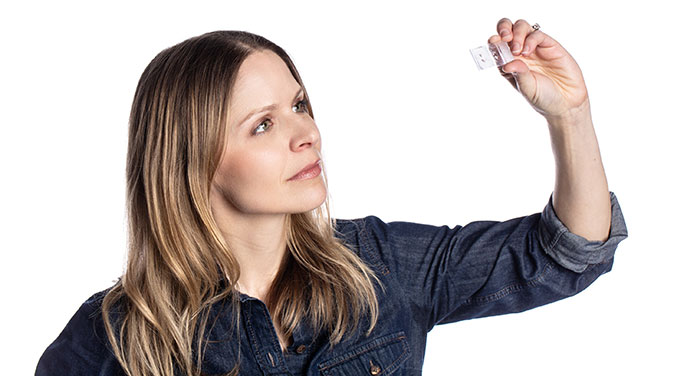
Meghan Riddell (centre) with undergrad research assistant Jasmine Nguyen (left) and PhD candidate Sumaiyah Shaha. Both trainees say they’ve benefited from the mentorship and team atmosphere in Riddell’s lab. (Photo: Supplied)
Jasmine Nguyen signed up for a tour of Meghan Riddell’s cell biology lab as a first-year undergrad in the Faculty of Science and was immediately hooked.
“Meghan pulled a placenta out of what was basically a lasagna dish and it was love at first sight,” said Nguyen, who’s now working on her fourth-year honours thesis in Riddell’s lab and is filling out applications for medical school.
Nguyen found her career path and tapped into a unique support system that has been fostering boundary-pushing scientists in women and children’s health for the past 15 years.
Nguyen, her mentor Riddell, and her mentor’s mentor, Distinguished University Professor Sandy Davidge, have all been funded by the Women and Children’s Health Research Institute (WCHRI). WCHRI supports 400-plus researchers, thanks to partnerships with the University of Alberta, Alberta Health Services, Stollery Children’s Hospital Foundation and Alberta Women’s Health Foundation. WCHRI is celebrating its 15th anniversary this fall.
Not to go overboard with the pregnancy analogies, but Riddell sees trainees like Nguyen as Davidge’s grandchildren in science.
“They are the next generation.”
Riddell’s lab has uncovered a novel method for making a placenta in a petri dish. This amazing organ is run largely by one cell, which regulates nutrition, waste and many other functions for the fetus during the nine months of pregnancy. Being able to create an artificial placenta will make it easier to study how it works and how it can malfunction, and will ultimately lead to precision treatments for pregnancy complications.
“Nobody would be here without a placenta, yet the placenta is a critically understudied organ,” said Riddell, assistant professor of obstetrics and gynecology in the Faculty of Medicine & Dentistry. “It’s the most important organ you no longer have, and it really does determine the life trajectory for health.”
Riddell began her research on the placenta while doing a PhD under Sandy Davidge, who is executive director of WCHRI and held the Canada Research Chair (Tier 1) in Maternal and Perinatal Cardiovascular Health. Davidge’s work focuses on how a lack of oxygen during pregnancy can impair the cardiac health of both mother and baby later in life. Riddell went to Germany to the prestigious Max Planck Institute for Heart and Lung Research for post-doctoral studies but was recruited back to Alberta to oversee her own lab in 2019.
It was the focus on women and children’s health research – and the financial support to make it happen – that drew Riddell back to the U of A.
“It was a huge advantage to come where I knew there would be systematic support for my research in the form of summer studentships and graduate studentships and innovation grants,” said Riddell, whose lab has also attracted funding from the Natural Sciences and Engineering Research Council of Canada and the Canadian Institutes of Health Research.
“That didn’t exist in Germany.”
One of the things Riddell was most looking forward to about becoming a principal investigator with a lab of her own was the chance to mentor younger scientists, just as Davidge had nurtured her.
“The science had to be absolutely exceptional – she didn’t accept anything less – but she always considers people first and science second,” Riddell explained. “I try to build skills in my trainees that are transferable to other situations because it should be an investment in the person and in their life.”
Nguyen said she has learned valuable life skills such as project management, writing and presentation skills from Riddell. Also perseverance.
“Science is one of those fields where you fail all the time,” Nguyen said. “That’s something that I’ve taken from Meghan’s lab, and now I just apply it to my daily life because the reality is things don’t work out the first time all the time.
“You can either let it get you down and or you can pick yourself up, try it again or try something new.”
Nguyen is encouraging the next generations of scientists by teaching high-school students about research through the volunteer group Youreka Canada. She also trains the grad students as Riddell’s lab expands, helping them to understand protocols and master experimental techniques.
Like Nguyen, PhD candidate Sumaiyah Shaha appreciates the mentorship and team atmosphere in Riddell’s lab.
“I love collaborating with others, and I can’t see myself in a position where I’m ever not learning,” Shaha said. “In our lab group, there’s so much expertise there; you can always go to anybody for help.”
It’s an exciting time to be in placental research, Shaha said, with new research papers published every month. She hopes to continue working to understand how the immune system interacts with the giant surface cell of the placenta, which can be as large as 12 square metres by the end of pregnancy.
“How the immune system doesn’t recognize or doesn’t target the placenta and the developing fetus is quite fascinating,” she said.
All of the work carried out by Davidge, Riddell, Nguyen, Shaha and others at the U of A will ultimately translate into better outcomes for Alberta mothers and their babies.
“We’re looking at what goes wrong during complications in pregnancy so we can come up with treatments for the future,” Riddell said. “That investment by WCHRI will allow us to have homegrown solutions.”
| By Gillian Rutherford
Submitted by the University of Alberta’s Folio online magazine. The University of Alberta is a Troy Media Editorial Content Provider Partner.
© Troy Media
Troy Media is an editorial content provider to media outlets and its own hosted community news outlets across Canada.

